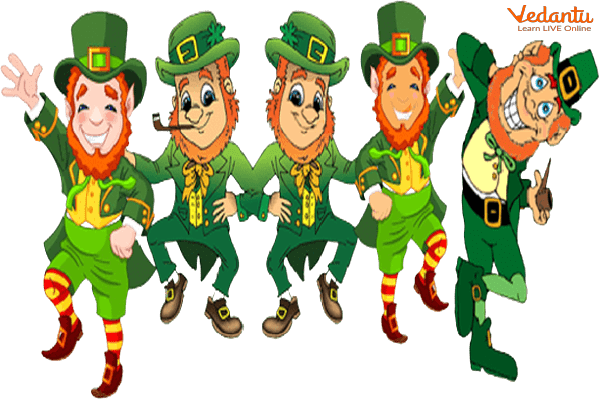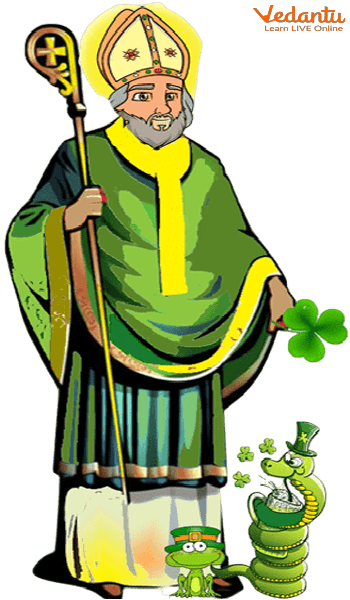Children's Story of St. Patrick

About St. Patrick’s Day
In Ireland, St. Patrick's Day has been observed since the ninth century, or almost 1,000 years. According to historians, the first parade commemorating St. Patrick's Day took place on March 17, 1601, but it wasn't in Ireland; instead, it was in the Spanish province of St. Augustine, Florida. Irish Vicar Ricardo Artur of the Spanish colonies invented the march and festivities.
The St. Patrick's Day festivities arrived in America around 1772. To commemorate St. Patrick's Day and the life of Saint Patrick, Irish troops serving in the English army marched through New York City. From this point forward, the festivities in America became more well-known, inspiring new communities to participate.

Celebration of St. Patrick
Children's Story of St Patrick
Although Saint Patrick is the patron saint of Ireland, historians believe he was born in Wales around the end of the fourth century. Although specific dates are still unknown, it is believed that he was born around 385 AD. He went under the name Maewyn Succat.
Patrick was taken captive by Irish robbers when he was a teenager, and he was later sold to an Irish farmer in the Antrim region. He was made to care for pigs and lambs on a remote hill while being treated like a slave.
He was starving and neglected in this place, and to alleviate his misery, he finally turned to God and Christianity. He was imprisoned here for six years before seeking solace in the Bible and in prayer. One night, he had a dream in which he heard the voice of God telling him to leave this mountain and travel to a harbour, where a boat would be waiting to assist him in leaving and take him back home.
He trusted the voice because of the new, strong faith he had and started his attempt to flee. He managed to reach a port where he was allowed to board a ship and made his way back home. He persisted in his devotion to God and later attained the position of priest in a monastery in Tours, France. Additionally, before going back to Britain, he rose through the ranks to become a Bishop.
Patrick went back to Ireland to spread the gospel and teach the people about God and Christianity since, at the time, it was a pagan nation that did not practice Christianity. He encountered much opposition when he initially tried to spread the message in Ireland. He eventually succeeded in disseminating his ideas by preaching, baptisms, and writing.

Illustration Showing St Patrick
He acknowledged that many Pagan spiritual practices and beliefs had already become widespread in Ireland. Many people think Saint Patrick invented the Celtic Cross as a fusion of Pagan sun-worship symbolism and the conventional Christian cross. He absorbed some of these rites into his brand of Christianity. He may have also utilized the Irish shamrock as a parable, with each leaf standing for a different aspect of the Holy Trinity. The Trinity of God the Father, God the Son, and God the Holy Spirit are represented by this.
Saint Patrick spent the following 60 years traveling throughout Ireland, evangelizing for the Catholic religion and the word of God. For the sake of completing this effort, he gathered nearly 350 Bishops at this period.

People Celebrating St Patrick Dressed up as the Saint
He purportedly passed away in the region that is today known as County Down on March 17, 461 AD. This day is observed as St. Patrick's Day in Ireland and other countries.
Summary
St. Patrick's Day is the feast day (March 17) of the Irish national patron saint, St. Patrick. He was abducted at the age of 16 and sent to Ireland as a slave. He was born in Roman Britain in the late 4th century. He managed to flee, but he later came back in 432 CE to win the Irish over to Christianity. He had built monasteries, churches, and schools by the time he passed away on March 17, 461 AD. He was the subject of several myths, including the ones that claimed he expelled the snakes from Ireland and explained the Trinity using the shamrock.


FAQs on Children's Story of St. Patrick
1. What are St. Patrick's views on God?
Saint Patrick was born in England but was kidnapped by Irish pirates when he was a youngster and brought to Ireland as a slave. He escaped after six years to England. To share his knowledge of God with the public, Saint Patrick returned to Ireland as a missionary. The Trinity was equated to a shamrock by him. Although the shamrock is simply one plant, he claimed it had three leaves. God is three individuals but only one God in the same manner.
2. How is St. Patrick’s day celebrated?
The Catholic Church, the Anglican Communion (particularly the Church of Ireland), the Eastern Orthodox Church, and the Lutheran Church all mark Saint Patrick's Day, which was proclaimed an official Christian feast day in the early 17th century. The holiday honours Saint Patrick, the introduction of Christianity to Ireland, and the Irish people's heritage and culture. Celebrations typically include céilithe, shamrock- or green-themed apparel, parades, and festivals.




